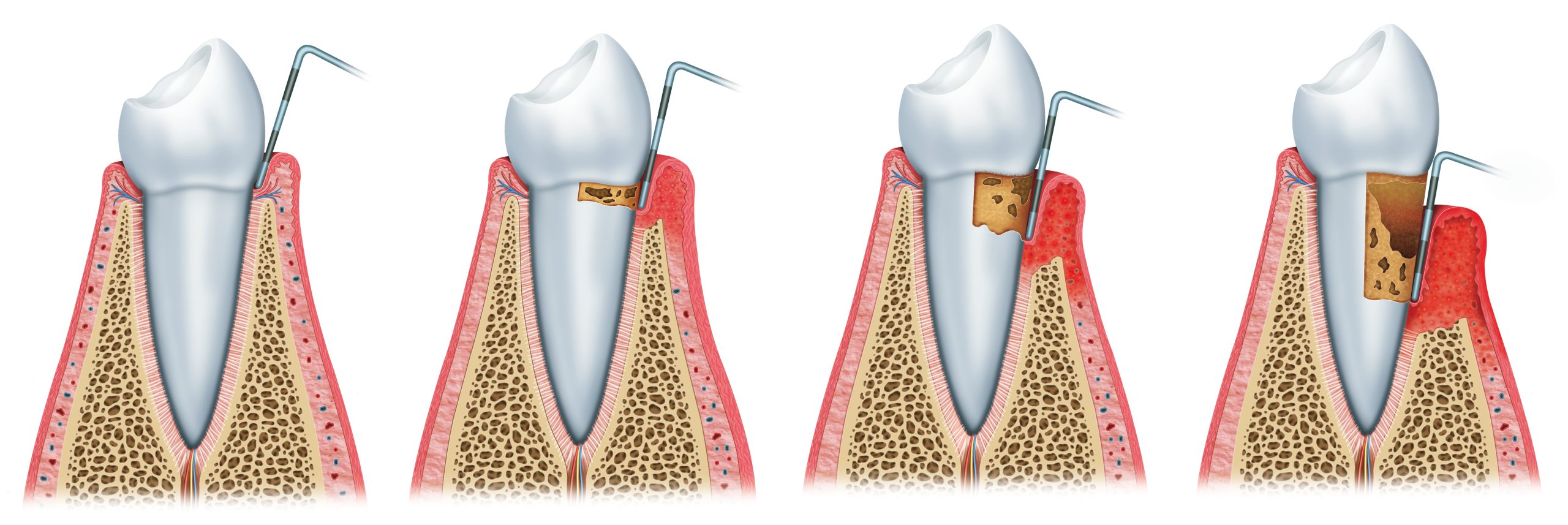
What causes bone loss around teeth?
Bone loss around teeth is caused by a condition known as periodontitis, which is an inflammation of the gums and bone around teeth. This condition is primarily caused by bacteria in plaque, a sticky film that forms on the teeth and contains harmful microorganisms. When plaque is not removed regularly through proper oral hygiene, the bacteria can infect the gums and lead to inflammation, which is called “gingivitis.”
Over time, plaque builds up and hardens into tartar, also known as calculus. This calculus irritates the gums and causes them to get inflamed and swollen, creating pockets between the tooth and gums that can become infected as bacteria from the mouth migrate into the gums. These infected pockets then lead to an even greater difficulty with cleaning the tartar. The inflammation that results can spread to the bone surrounding the teeth and cause it to break down, resulting in bone loss, which is called “periodontitis.”

The first image shows a healthy tooth with healthy bone and gums. If the gums become red but the bone level is unaffected, that is called gingivitis.
The second, third, and fourth images show the progression of periodontal disease, which means bone loss. Periodontal disease is most often a result of calculus / tartar buildup on the tooth/root surface. If the calculus is not removed through a process called Scaling and Root Planing, the gums remain infected and the bone loss progresses.
Other factors that can contribute to bone loss around teeth include trauma from brushing too hard or from the pull of frenum attachments (which are small muscular attachments between the gum tissue and the cheeks or lips), smoking (due to diminished blood supply), hormonal changes (such as during pregnancy) and certain medical conditions such as diabetes (again due to diminished blood supply).
Gingival biotype plays a role in bone loss as well. People with a “thin gingival biotype” have less bone between their teeth and thus are at a higher risk of experiencing horizontal bone loss and recession around their teeth, especially if they brush too hard and traumatize their gums. On the other hand, people with a “thick gingival biotype” have more bone between their teeth, providing better support and protection against bone loss, however when people with ‘thick gingival biotype” get calculus buildup under their gums, the bone loss tends to progress vertically towards the root.
It is important to note that bone loss around teeth can occur at any age and can affect anyone, regardless of their oral hygiene habits. If bone loss around the teeth is not treated, it can lead to loose teeth and ultimately tooth loss.
The best way to prevent bone loss around teeth is to maintain good oral hygiene practices, including regular brushing and flossing, as well as routine dental cleanings. If you notice any signs of gum disease, such as red or swollen gums, bleeding while brushing or flossing, or persistent bad breath, it’s important to see a dentist for treatment before the condition progresses further.
In addition, it’s important to make lifestyle changes such as quitting smoking and managing any underlying medical conditions that may contribute to periodontitis. By taking these preventive measures, you can help maintain the health of your teeth, gums, and supporting bone structure.
If you have already experienced bone loss around your teeth, there are treatments available to prevent further bone loss and to potentially help to restore some of the lost bone. These may include deep cleaning procedures, localized antibiotics, and regenerative treatments such as the Laser Assisted New Attachment Procedure (also known as LANAP), bone grafting, and guided tissue regeneration. Your dentist will be able to evaluate your specific case and recommend the best course of treatment for you.
In conclusion, periodontitis is the primary cause of bone loss around teeth, but is a condition that can be prevented early on, and managed through good oral hygiene and lifestyle choices, and regular dental cleanings.
